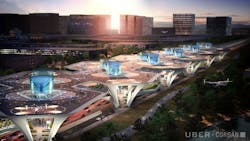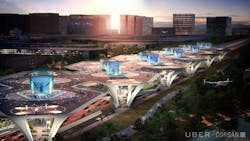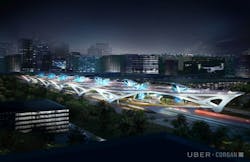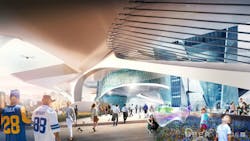Flying taxis to usher in networks of skyports, cost savings over traditional infrastructure
LOS ANGELES. Unmanned aircraft systems (UAS), commonly referred to as drones, and small, commercial, manned aircraft operating as flying taxis are likely to change the face of airports worldwide. Architecture and design firm Corgan in Dallas revealed its CONNECT Uber Mega Skyport concept, designed to provide the infrastructure to support and scale UberAIR service.
Corgan’s CONNECT Skyport concept supports vertical take-off and landing (VTOL), passenger throughput, and aerial vehicle fleet maintenance with the flexibility to accommodate up to 1,000 landings per hour — revolutionizing point-to-point transport into a seamlessly integrated urban ecosystem, officials say.
Corgan’s design concept for the Uber Mega Skyport system was revealed at the 2018 Uber Elevate Summit. The modular system features a scalable design that can be adapted anywhere for convenient access to UberAIR. (Photo: Business Wire)
The development of infrastructure to support an urban VTOL network will likely have significant cost advantages over heavy-infrastructure approaches, such as roads, rail, bridges, and tunnels, Uber officials explain. “It has been proposed that the repurposed tops of parking garages, existing helipads, and even unused land surrounding highway interchanges could form the basis of an extensive, distributed network of “vertiports” (VTOL hubs with multiple takeoff and landing pads, as well as charging infrastructure) or single-aircraft “vertistops” (a single VTOL pad with minimal infrastructure).” As costs for traditional infrastructure options continue to increase, the lower cost and increased flexibility provided by these new approaches may provide compelling options for cities and states around the world, officials add.
Corgan’s modular system is adaptable anywhere and can operate independently, be paired for efficiency, or be stacked to maximize throughput at Uber Mega Skyports.
Corgan’s Skyport design is comprised of multiple components. An elegant structure that spans the highway, reclaiming land in the sky and the icon for a new and innovative transportation hub. (Photo: Business Wire)
Where individual landing pads provide on-demand connectivity at popular locations, Corgan’s design coordinates with established highway networks to create new travel arteries that can accommodate the higher throughput required of mass adoption. Built above highways, the design solves for widespread infrastructure by repurposing familiar frameworks and amplifying efficiency and convenience to create a new culture of urban mobility while reconnecting the communities they serve.
Corgan’s CONNECT module consists of four components: The Bridge is a futuristic structural piece sculpted by passenger flow helping visitors navigate the Skyport, whereas the Connection Plaza is an iconic entry to the amenities at the Station, a concourse, which connects passengers to the crowning Flight Deck.
In addition to scalability, CONNECT provides solutions to potential challenges in getting eVTOLs off the ground. Situating Skyports within existing highways and noise corridors minimizes added noise and intrusion. Floor movement and tug propulsion strategies allow for safer, longer passenger loading and unloading without backing up operations.
“Our expertise in aviation design coupled with our vision for future air travel allowed this project to dovetail with our existing urban air research,” says John Trupiano, principal in Corgan’s Aviation studio. “It’s an incredibly exciting time to not only visualize what could be, but start to see things become a reality.”
The heart of the Skyport, the Station is not only a concourse that serves the Uber Elevate operations, but also a community destination offering an array of amenities. The Station will also have the adaptability to house community gatherings such as art shows, farmer’s markets and performance events. (Photo: Business Wire)
Corgan officials explored three major configurations to meet throughput demand, limit movement near the launching areas, and provide for intuitive wayfinding. The modular design is flexible for several site conditions including open fields, rooftops, and site-constrained urban environments.
Corgan’s CONNECT concept services Uber pick-up and drop-off zones and public transit through the Connection Plaza, and functions as a community destination to reconnect the urban fabric. The amenity-rich Station offers daily commuters, stadiums full of football fans, and tourists alike a dynamic place to shop, dine, or visit an art show.
Advancing aerial travel is part of Corgan’s heritage and has motivated recent research related to designing the holdroom of the future, advanced wayfinding techniques and an airport that fights jet lag.
For eight decades, Corgan has developed special expertise in aviation, commercial, critical facilities, education, healthcare, and interior design projects.



